
As AV turns 15, let's take a look back at the site we descended from. Below you can explore the database Olivier compiled at Animated Movies during its existence, as it last appeared online in October 2003.
 | Animated Movies was launched by Olivier Mouroux in 1999. In addition to a daily news report, he also created a database of information about past, current, and upcoming films. In 2003, he took a job in the industry and had to give up his work on the site. Several fans of Animated Movies decided to take on the task of keeping the news portion of his site going, and founded what is now Animated Views. As AV turns 15, let's take a look back at the site we descended from. Below you can explore the database Olivier compiled at Animated Movies during its existence, as it last appeared online in October 2003. |
Biographies * Story of the Studio * An all-time favorite: Scooby-Doo!
 |
 |
Born in Melrose, New Mexico, on July 14, 1910, William Denby Hanna joined a California engineering firm after studying engineering and journalism. He switched careers to cartooning in 1930 and began his animation career at the famous Harman-Ising Studios. In 1937 joined Metro-Goldwyn-Mayer as a director and story man in the animation department, where he later also became a producer. William Hanna died in March 2001 at age 90, at his home in North Hollywood with his wife of 65 years, Violet, by his side. Animation veteran Floyd Norman commented at the time of his death: "Bill Hanna was one of the toughest bosses I ever worked for. He was a mean no-nonsense business man. Yet, he was one of the nicest men I ever knew. The people running animation studios today make William Hanna look like a saint."
Born in New York, NY on March 24, 1991, Joseph
Barbera was working as a bank accountant with the Irving Trust
Company in Manhattan when he started submitting cartoons to magazines:
he sold his first one to Collier's magazine and decided to forsake banking
for cartooning, and joined MGM as a sketch artist. Since selling
their studio, Joseph has remained as active as ever in animation. He helped
bring an old-fashioned gusto to a "Tom and Jerry Kids" TV series in the
late 1980s, and coproduced a less successful feature, Tom and Jerry:
The Movie in 1992.




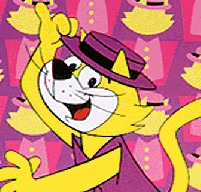

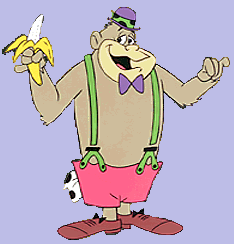
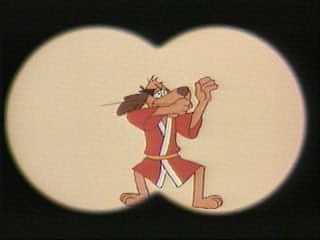
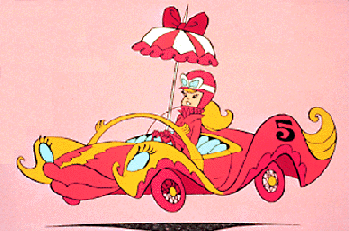
 |
In 1939, William Hanna was hired
by MGM and coupled up with another animator who
didn't impress anyone so far, Joseph Barbera. Hanna and Barbera somehow
connected with each other and fused into a fantastic team. They complemented
each other perfectly with Hanna's keen sense of timing and Barbera's creative
gag writing. Their first production - Puss Gets The Boot -
was prophetic, winning an Oscar nomination. Their creative partnership
would last more than 60 years.
Together, they created the Tom and Jerry characters and produced a mass of films in the series between 1940 and 1958. The success was immediate: as Joe Barbera recalls, "Every time we previewed a cartoon, people didn’t know what they were going to get. And all of a sudden, it would come on the screen -Tom & Jerry- and the yell that went up would make you feel good for 20 years!" At MGM, they revolutionized animation by mixing it with live action, as their cat and mouse characters Tom and Jerry danced with Gene Kelly in "Anchors Aweigh" and "Invitation To Dance," and with Esther Williams in "Dangerous When Wet." They won seven Oscars from the Academy of Motion Picture Arts and Sciences for their cartoons between 1943 and 1952. After MGM closed its animation division in the 1950s, Hanna and Barbera moved into TV, founding their own company - Hanna-Barbera - in 1957. Just three years after getting started, the pair's "Huckleberry Hound" won the first Emmy Award ever given for an animated series, and launched the first animated prime-time show, a parody of "The HoneyMooners" titled "The Flintstones." After the stone age, they tried the space age with The Jetsons. Many others followed: Top Cat, based on the Phil Silvers character Sergeant Bilko; Wacky Races with Dick Dastardly and his sniggering hound Mutley; Yogi Bear; The Hair Bear Bunch and Hong Kong Phooey. In 1976, Hanna and Barbera received stars on the Hollywood Walk of Fame; they were inducted into the Television Academy Hall of Fame in 1993. The collection of Hanna-Barbera characters remains popular: Hanna served as executive producer for Universal Pictures' 1994 live-action version of "The Flintstones," and production began this year on a live-action film based on "Scooby-Doo, Where Are You?", which Hanna-Barbera produced for 17 years and maintains the title of television's longest-running animated series, according to Warner Brothers. Hanna-Barbera produced more than 3,000 half-hour TV animations, winning eight Emmys. |
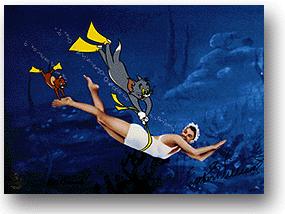

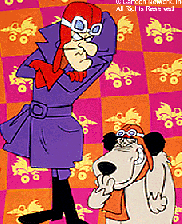

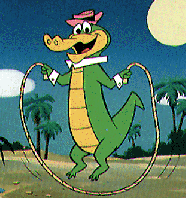
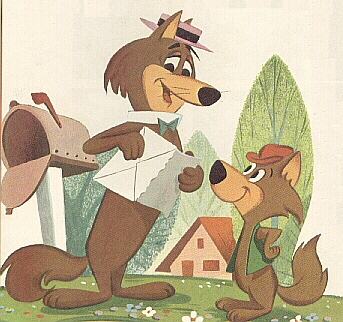
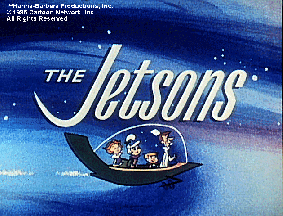

 |
Scooby-Doo, Where Are You? premiered on Sept. 3, 1969, on CBS--but it almost didn't make it on the air. The network's children's programming executive at the time, Fred Silverman, wanted to create an animated show centered around a group of teens who travel around and solve mysteries. The initial concept combined elements from I Love a Mystery, a popular radio mystery from the '40s, in which three detectives roamed the world solving crimes and mysteries, and used the characters from the 1959-1963 CBS sitcom The Many Loves of Dobie Gillis, about a scatterbrained teenager and his friends, as archetypes for the show's mystery-solving protagonists.
 Silverman's
quest was brought before Hanna-Barbera who assigned writers Ken Spears
and Joe Ruby to create the characters, plots, and many of the story lines.
The show actually started out revolving around four teenage detectives
who traveled the country in a van, called the Mystery Machine, solving
mysteries in dangerous situations. A Great Dane accompanied the foursome
but was not a prominent character. The show was first known as Mysteries
Five and later changed to Who's Scared? The show was then presented
to the top CBS management and president Frank Stanton as a new Saturday
morning cartoon for the fall of 1969. There was just one problem. The artwork
was very frightening which led Stanton to reject the show.
Silverman's
quest was brought before Hanna-Barbera who assigned writers Ken Spears
and Joe Ruby to create the characters, plots, and many of the story lines.
The show actually started out revolving around four teenage detectives
who traveled the country in a van, called the Mystery Machine, solving
mysteries in dangerous situations. A Great Dane accompanied the foursome
but was not a prominent character. The show was first known as Mysteries
Five and later changed to Who's Scared? The show was then presented
to the top CBS management and president Frank Stanton as a new Saturday
morning cartoon for the fall of 1969. There was just one problem. The artwork
was very frightening which led Stanton to reject the show.
Fred Silverman immediately flew back to Los Angeles that night. While listening to the earphones on the flight back, Silverman was relaxing to Frank Sinatra singing "Strangers in the Night." The phrase 'Scooby-dooby-doo' struck Silverman so much that he went back and said 'We'll call the show Scooby-Doo, Where Are You? and we'll make the dog the star of the show.' And with those words Scooby-Doo was created with the other characters supporting him.
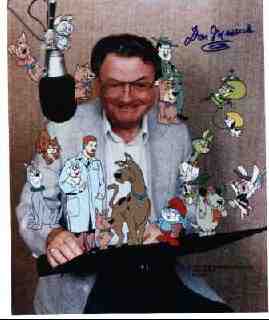 The
new show was now more comical then mysterious. Don Messick became Scooby
with his trademark laugh and scratchy voice, Top-Forty DJ Casey Kasem became
Shaggy who was always in a constant state of panic and hunger which also
served as Scooby's partner, Frank Welker became blond Freddy, Nicole Jaffe
became brainy and bespectacled Velma, and the trouble-prone, sexy, Daphne
was the voice of Heather North.
The
new show was now more comical then mysterious. Don Messick became Scooby
with his trademark laugh and scratchy voice, Top-Forty DJ Casey Kasem became
Shaggy who was always in a constant state of panic and hunger which also
served as Scooby's partner, Frank Welker became blond Freddy, Nicole Jaffe
became brainy and bespectacled Velma, and the trouble-prone, sexy, Daphne
was the voice of Heather North.
 There
were other voices that supported the main crew. One worth mentioning is
David Coulier, star of America's Funniest People and Full House
(not to be confused with Bob Saget). The teenage Coulier made a voice tape
that told a story and mailed it to Hanna-Barbera on a Friday. The next
Monday Hanna-Barbera called Coulier and said "We have work for you on Scooby-Doo."
Coulier was only 18 years old!
There
were other voices that supported the main crew. One worth mentioning is
David Coulier, star of America's Funniest People and Full House
(not to be confused with Bob Saget). The teenage Coulier made a voice tape
that told a story and mailed it to Hanna-Barbera on a Friday. The next
Monday Hanna-Barbera called Coulier and said "We have work for you on Scooby-Doo."
Coulier was only 18 years old!
The original Scooby Doo series enjoyed wide popularity from the time
of its premiere in September of 1969. The original Scooby Theme Song has
an interesting story behind it....this is how the Scooby Doo Theme originated:
"According to Larry Marks, Ben Raleigh was one of the writers of the original theme. Ben had written some early rock and roll songs from Tin Pan Alley. Larry was a music exec and studio singer. When they first played the song for him - Larry suggested they add the line Scooby Dooby Do - here are you -because they needed some words for that line! Although the song was written ahead of time- it was recorded on the Wednesday --just a few days before the first ever episode aired on the Saturday! Larry Marks sang both the original theme and all of the background parts!"Pam Marks, Larry's wife
By 1972 CBS decided that a change in the format should arrive which
gave birth to the Scooby Doo movies incorporating the voices of such guest
stars as Phyllis Diller, Tim Conway, Jonathan Winters, Don Knotts, the
Addams family, and Laurel and Hardy. After seven years with CBS, Scooby
moved to ABC to start the Scooby-Doo/Dynomutt Hour which saw the rise of
the two canine characters Scooby-Dum and Scooby-Dear. The following year
saw the first two-hour Saturday morning cartoon show in the network history,
the highly successful Scooby's All-Star Laff-a-lympics. In 1978 more episodes
of Scooby-Doo were added to a smaller version of Laff-a-lympics which was
renamed to Scooby's All-Stars. 1979 was the year of Scooby's first television
special, Scooby goes to Hollywood which combined slapstick and parody with
a sprinkling of music. 1979 was also the year Scrappy-Doo was introduced.
The eighties showed various combinations of Scooby and his friends that continued to entertain children and adults of all ages. Why is Scooby-Doo so popular? Don Messick (the voice of Scooby) sums it up real well.....
"I've loved Scooby from the inception, and so has everyone else. I think it's because he embraces a lot of human foibles. He's not the perfect dog. In fact you might say he's a coward. Yet with everything he does, he seems to land on his four feet. He comes out of every situation unscathed. I think the audience - kids and more mature people as well - can identify with Scooby's character and a lot of his imperfections."
 |
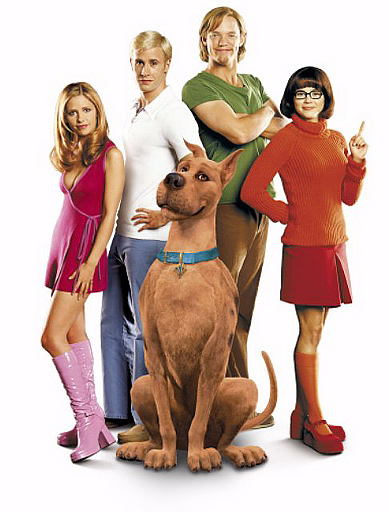 |
Mark Evanier, who wrote for the series in 1979 when it aired under the title The Scooby and Scrappy-Doo Show, summarizes that CBS "kept threatening to cancel the show every year or two, so every season they had to add a new element to the show to keep it fresh." The show was a staple of Saturday mornings from 1969 to 1991. It went through more than nine incarnations before ABC canceled the last series, A Pup Named Scooby-Doo, which featured the teens as kids and the dog as a puppy. "They probably kept the show on longer than they should have, but a cold hard fact of the TV business is you don't say no to a network," says Mark Evanier.
But more than 30 years after his creation, Scooby-Doo seems more successful
than ever, with new straight-to-video adventures regularly topping the
best-seller lists at Halloween time, a live-action blockbuster and a brand
new TV series, What's New Scooby-Doo?, in 2002!